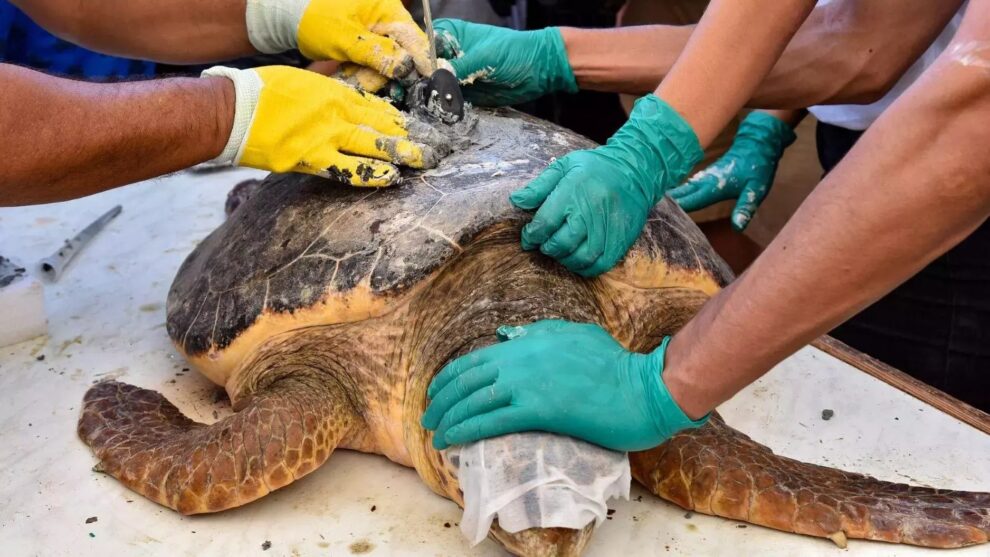Rose heads out to sea in eastern Tunisia. This twenty-year-old turtle has just left a unique place in the Maghreb that offers a second chance to her species, threatened by overfishing, pollution and climate change.
More than a month ago, she had become entangled in fishing nets before being taken to the “Sea Turtle First Aid Center” in Sfax (central-eastern Tunisia), a member of the European “Life Med Turtles” program, one of two of its kind in Tunisia along with the one in Monastir (eastern Tunisia).
In North Africa, these are the only care facilities for the loggerhead turtle, or Caretta Caretta by its scientific name, the most widespread species in the Mediterranean and one of the most at-risk.
In addition to caring for injured turtles, which, like Rose, can remain there for a month or more, the Center uses beacons to track their migratory movements, and strives to raise awareness among local populations in the Gulf of Gabès, who are dependent on fishing.
“Before, we were ignorant. People ate (the turtles), used them for witchcraft or as medicine. Today, thanks to the awareness of fishermen, it has a better chance of surviving and protecting our ecosystem,” explains Hamadi Dahech, a 29-year-old fisherman, as he watches his protégé Rose, whom he rescued in September, swim away from the shore.
– Caught in the trap –
At least 10,000 Caretta Caretta are caught each year in fishermen’s nets in the Gulf of Gabès, a sign of the species’ strong presence in the area, despite intense industrial and chemical activity.
The Life Med Turtles program, which covers five Mediterranean countries (Albania, Italy, Spain, Tunisia and Turkey), has revealed a very high mortality rate of 70%, linked to gillnets – suspended vertically from floats – where the turtles become trapped.
Now, at the Sfax Care Center, it’s often the fishermen who bring in the injured Caretta Caretta, recognizable by their enormous heads.
Some take the names of their rescuers, like Hamadi, a 46 kg male over 20 years old, who has just arrived, or Ayoub, a fragile baby turtle, syringe-fed by the carers.
Since the center was set up in the summer of 2021, almost 80 turtles have been treated here before being released back into the sea, explains Imed Jribi, head of the First Aid Center.
“We take samples for scientific research and treat the turtles to protect them. Then we return them to their natural environment”, he says.
According to him, the center has three objectives: protection, research and awareness, which is why it “is open to everyone, researchers, high school and university students.”
– Harmful to health –
On this particular weekend, Malak Morali, a 30-year-old mother, is taking part with her two children in an awareness campaign organized by Mr. Jribi.
“Every time he hears that there are going to be turtles, he wants to come and take photos and learn new things”, Malak points out, referring to her little boy who photographs Rose from every angle.
Thanks to this campaign, Malak has learned that turtle meat is “harmful” to health. “We used to say that once cooked, it was good, but it’s the opposite,” she says.
Due to heavy pollution of their habitat, Caretta Caretta absorb toxic metals such as mercury, which can harm human health.
Turtles are also highly threatened by plastic pollution, “because they mistake plastic bags for jellyfish”, which they love, according to Hamed Mallat, a marine biology researcher.
Global warming, and the rise in sea temperatures it brings with it, also represents a serious threat, “not least for the imbalance it causes in the turtles’ sex ratio”, explains Hamed Mallat.
According to a study by the National Ocean Service (USA), if a turtle incubates its eggs below 27.7 degrees Celsius, it will also produce males, but above 31 degrees Celsius, it will only lay females, with the risk of extinction of the species.
Source: Africa News















